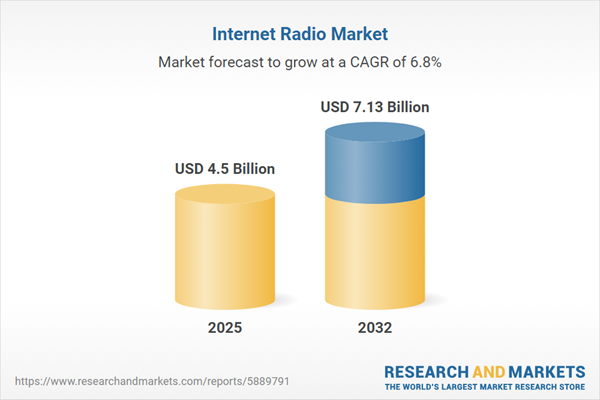Speak directly to the analyst to clarify any post sales queries you may have.
The internet radio market is experiencing significant transformation as digital audio consumption becomes embedded in daily routines worldwide, driven by user-centric innovation and evolving connectivity. Senior executives seeking strategic clarity on the sector’s direction will find comprehensive analysis and actionable insights in this report, supporting confident decision-making for both platform and device investments.
Market Snapshot: Internet Radio Market Outlook
The Internet Radio Market grew from USD 4.21 billion in 2024 to USD 4.50 billion in 2025. It is expected to continue growing at a CAGR of 6.80%, reaching USD 7.13 billion by 2032. These figures reflect the ongoing shift towards seamless digital listening and increasing demand for integrated user experiences across devices and contexts. Stakeholders are adapting to new consumer expectations and rapid technological advances, positioning themselves to capture value in a dynamic competitive landscape.
Scope & Segmentation
- Device Type: Connected cars (aftermarket and OEM integration), desktop computers (Linux, MacOS, Windows), smartphones (Android, iOS), smart speakers (Amazon Echo, Apple HomePod, Google Nest), and tablets (Android, iPad OS).
- Access Mode: Desktop applications, mobile apps for Android and iOS, smart speaker apps, and web browsers provide multiple touchpoints for users.
- Content Type: Music streaming, news bulletins, sports updates, and talk radio formats cater to varied audience interests and time-of-day usage patterns.
- End User: Commercial establishments (including healthcare, hospitality, and retail) and individual consumers access tailored or curated content for atmosphere or personal entertainment.
- Payment Model: Ad-supported tiers, hybrid models, and premium subscriptions define monetization strategies targeting diverse consumer preferences.
- Advertising Type: Audio ads, display ads, and sponsorship opportunities enable advertisers to engage audiences in contextually relevant ways.
- Geographic Coverage: Americas (including major markets in North and Latin America), Europe, Middle East & Africa (with detailed country-level insights), and Asia-Pacific (driven by high mobile adoption and regional platforms).
Key Takeaways for Senior Decision-Makers
- The convergence of AI, machine learning, and next-generation network infrastructure is elevating personalization, content curation, and user engagement across platforms.
- Strategic alliances between technology providers and content creators foster new revenue opportunities and support rapid innovation in audio formats and user interfaces.
- Automotive and smart device integration is expanding, with connected cars and home speakers establishing new expectations for continuity and accessibility in internet radio experiences.
- Advertisers are leveraging dynamic ad insertion and contextual targeting, raising the importance of relevant messaging and diversified monetization pathways.
- Regulatory, infrastructure, and cultural variations at the regional level necessitate highly localized strategies to optimize content, distribution, and audience acquisition.
Tariff Impact: Navigating Policy and Supply Chain Shifts
The 2025 United States tariff regime introduced new duties on device components and digital content licensing. As a result, manufacturing and production strategies have adapted, with stakeholders realigning supply chains and renegotiating contracts to manage cost pressures. Emerging markets and distributors have implemented hedging techniques to mitigate tariff volatility, highlighting the need for agility and robust risk management within the internet radio value chain.
Methodology & Data Sources
This report utilizes a blend of primary and secondary research, including in-depth interviews with industry leaders, reviews of regulatory developments, and proprietary consumer surveys. Data triangulation enhances accuracy and ensures findings offer a comprehensive perspective across technology, commercial, and user domains.
Why This Report Matters
- Gain a unified, data-driven view of key market segments and emerging business models driving growth and resilience in internet radio.
- Understand regional nuances, regulatory complexities, and technology adoption trends, enabling informed go-to-market and product development strategies.
- Equip leadership teams with actionable intelligence to optimize investment decisions, navigate regulatory uncertainty, and build strategic alliances in a competitive environment.
Conclusion
The future of the internet radio market will be shaped by innovation, regional adaptation, and evolving user behaviors. Organizations that combine strategic agility with localized execution and advanced personalization are best positioned for sustained leadership in this evolving space.
Additional Product Information:
- Purchase of this report includes 1 year online access with quarterly updates.
- This report can be updated on request. Please contact our Customer Experience team using the Ask a Question widget on our website.
Table of Contents
3. Executive Summary
4. Market Overview
7. Cumulative Impact of Artificial Intelligence 2025
Companies Mentioned
The companies profiled in this Internet Radio market report include:- Spotify Technology S.A.
- Sirius XM Holdings Inc.
- Pandora Media LLC
- Apple Inc.
- Amazon.com, Inc.
- TuneIn Inc.
- Audacy, Inc.
- Deezer S.A.
- Jango.com, Inc.
- AccuRadio LLC
Table Information
| Report Attribute | Details |
|---|---|
| No. of Pages | 186 |
| Published | October 2025 |
| Forecast Period | 2025 - 2032 |
| Estimated Market Value ( USD | $ 4.5 Billion |
| Forecasted Market Value ( USD | $ 7.13 Billion |
| Compound Annual Growth Rate | 6.8% |
| Regions Covered | Global |
| No. of Companies Mentioned | 11 |









